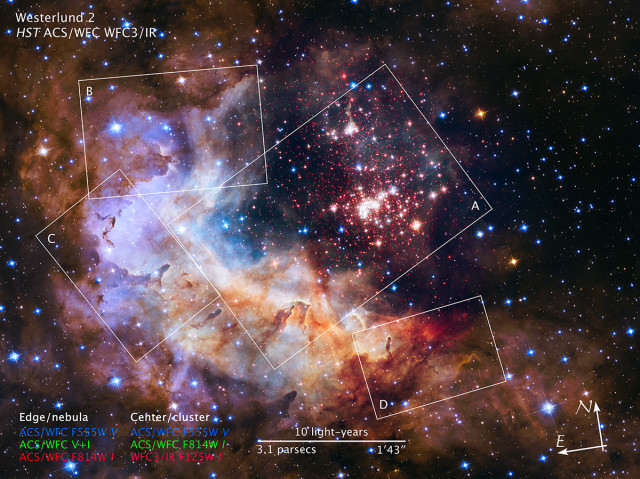Westerlund 2 is a giant star cluster located in a vast star-forming region Gum 29 (NGC 3247). The region is also known as the Whirling Dervish Nebula. The cluster and the nebula lie in the direction of the southern constellation Carina, at an approximate distance of 20,000 light years from Earth.
Westerlund 2 is about 6 to 13 light years across and contains some 3,000 stars. Its estimated age is only 2 million years. The cluster was named after Bengt Westerlund, the Swedish astronomer who discovered it in the 1960s.
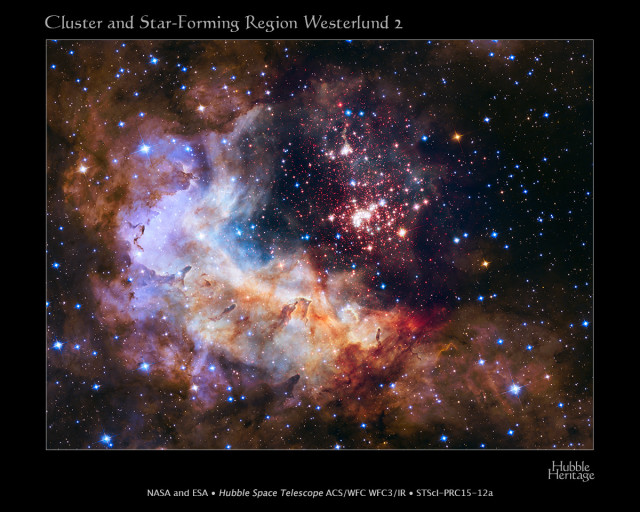
The glittering tapestry of young stars flaring to life in this new NASA/ESA Hubble Space Telescope image aptly resembles an expanding shell in a fireworks display. This vibrant image of the star cluster Westerlund 2 has been released to celebrate Hubble’s 25th year in orbit and a quarter of a century of new discoveries, stunning images and outstanding science. Image: NASA, ESA, the Hubble Heritage Team (STScI/AURA), A. Nota (ESA/STScI)
To celebrate the 25th anniversary of the Hubble Space Telescope launch on April 24, 1990, NASA released a series of new images and videos of Westerlund 2 and some of the Milky Way’s brightest, hottest, most massive stars, that reside in the cluster. The bright blue stars in the image are not members of the cluster, but mostly lie in the foreground. The red dots are forming stars that have not yet emerged from their cocoons of dust and gas.
The ultraviolet light and stellar winds of the bright, hot stars in the cluster are eroding and reshaping the surrounding clouds of dense dust and gas. They are also responsible for creating generations of new stars. When their stellar winds hit the walls of gas in the area, they create shocks which, in turn, generate new waves of star formation.
The nebula Gum 29 is difficult to observe because its light is obscured by the surrounding dust, but Hubble’s Wide Field Camera 3 has offered us a peek inside the stellar nursery, revealing the young stars in Westerlund 2 in near-infrared light. The image of the central region combines visible light data provided by the Advanced Camera for Surveys with near-infrared images taken by the Wide Field Camera 3. The image of the surrounding nebula is composed of visible light exposures taken by the Advanced Camera for Surveys.
The nebula is home to many pre-main sequence stars, two members that appear to be Wolf-Rayet stars, designated WR 20a (a binary star system) and WR 20b (a single star), and at least a dozen of O-type stars, including three eclipsing binaries.
WR 20a is one of the most massive binary stars ever discovered. Each component in the system has about 80 times the mass of the Sun. The system is believed to have formed in the cluster’s core, but now lies away from the centre of the cluster because it was probably ejected as a result of dynamical interactions.
Hubble’s 3D fly-through of Gum 29 is particularly impressive, and a wonderful way to celebrate the last 25 years of space exploration.
Images
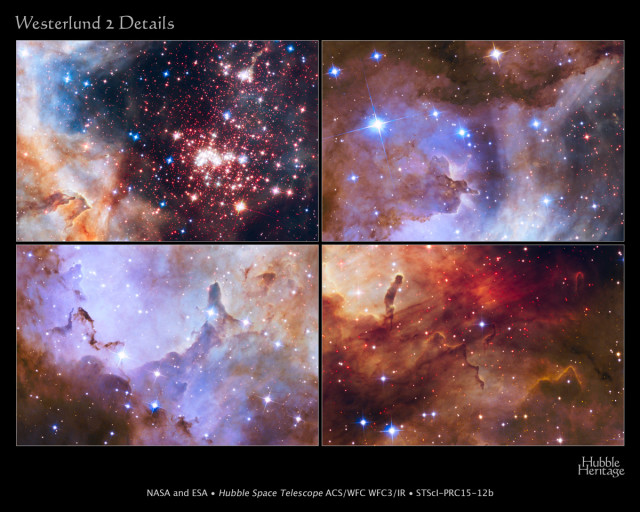
Westerlund 2 details. Credit: NASA, ESA, the Hubble Heritage Team (STScI/AURA), A. Nota (ESA/STScI), and the Westerlund 2 Science Team
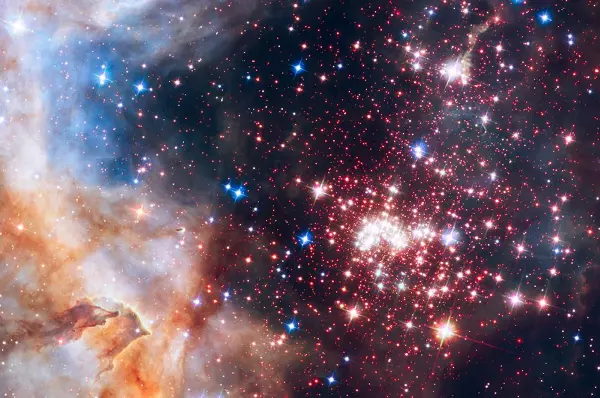
The sparkling centerpiece of Hubble’s silver anniversary tribute is Westerlund 2, a giant cluster of about 3,000 stars located 20,000 light-years away in the constellation Carina. Hubble’s near-infrared imaging camera pierces through the dusty veil enshrouding the stellar nursery, giving astronomers a clear view of the dense concentration of stars in the central cluster. The 2-million-year-old giant star cluster measures about 6 to 13 light-years across and contains some of our galaxy’s hottest, brightest, most massive stars. Image: NASA, ESA, the Hubble Heritage Team (STScI/AURA), A. Nota (ESA/STScI), and the Westerlund 2 Science Team
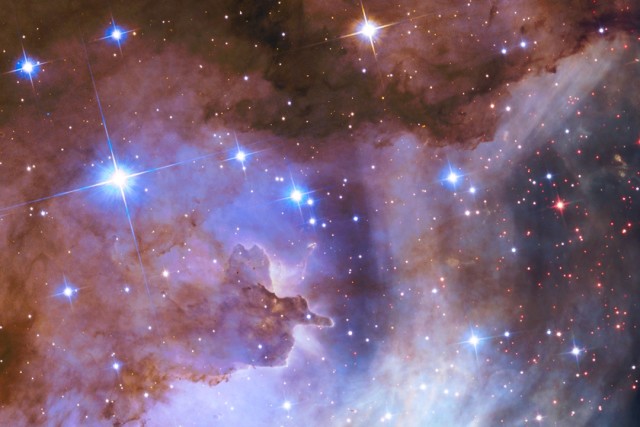
Westerlund 2 is surrounded by the star-forming region Gum 29. The heaviest cluster stars are unleashing a flow of ultraviolet radiation and hurricane-force winds blowing with charged particles, etching away the enveloping hydrogen gas cloud from where the cluster formed. The nebula reveals a fantasy landscape of pillars, ridges, valleys, and reddish-brown filaments of dense gas and dust. The brightest stars in the image are Milky Way foreground stars not associated with Westerlund 2. Image: NASA, ESA, the Hubble Heritage Team (STScI/AURA), A. Nota (ESA/STScI), and the Westerlund 2 Science Team
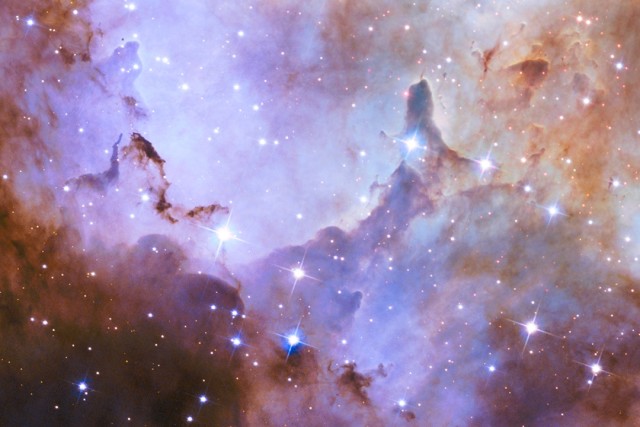
The pillars in the star-forming region surrounding Westerlund 2, composed of dense gas, are a few light-years tall and point to the central cluster. They are thought to be incubators for new stars. Besides sculpting the gaseous terrain, intense radiation from the most brilliant of the cluster stars is creating a successive generation of baby stars. The bluish haze is an indicator of oxygen gas in the nebula. Image: NASA, ESA, the Hubble Heritage Team (STScI/AURA), A. Nota (ESA/STScI), and the Westerlund 2 Science Team
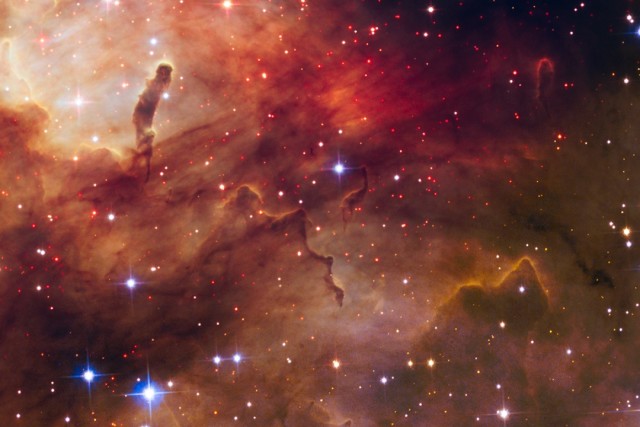
The red dots scattered throughout the landscape around Westerlund 2 are a rich population of newly forming stars still wrapped in their gas-and-dust cocoons. These tiny, faint stars are between 1 million and 2 million years old and have not yet ignited the hydrogen in their cores. Hubble’s near-infrared vision allows astronomers to identify these fledgling stars. Credit: NASA, ESA, the Hubble Heritage Team (STScI/AURA), A. Nota (ESA/STScI), and the Westerlund 2 Science Team
